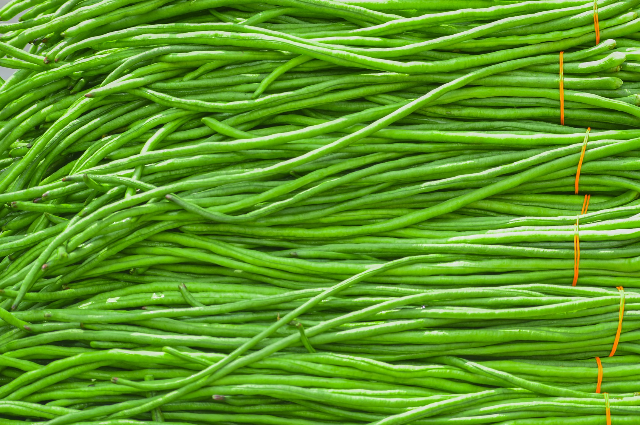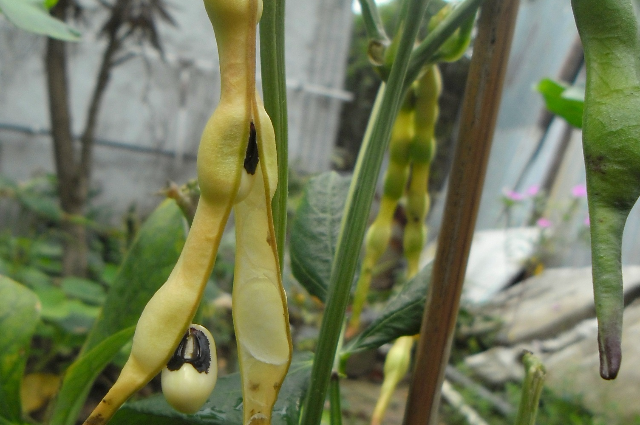
The cowpea (2n=2x= 22) is an annual herbaceous legume that belongs to the genus Vigna and the family Fabaceae. It is scientifically known as Vigna unguiculata. Cowpea is an important crop in the semiarid regions across Africa and Asia due to having tolerance capacity for sandy soil and low rainfall (Badiane et al., 2004). The term ‘cowpea’ was originated from the fact that the cow uses this plant as an important source of hay in the Southeastern United States and in the other regions of the world (Timko et al., 2007).
Literature on the diversity of cowpea was revealed and noticed by several workers. Cowpea plays a significant role in animal feeding and human consumption due to its high protein, vitamin, and minerals content (Singh et al., 1997; Nielsen et al., 1997; Badiane et al., 2004). Only a few studies have been reported regarding the selection of cowpea varieties on the basis of their water stress tolerance. Badiane et al. (2003) developed screen cowpea varieties according to their tolerance capacity to drought and they also developed an in vitro technique using polyethylene glycol (PEG) to induce water stress.
The morphological and phenological characteristics, nutritional composition as well as a genetic map and transgenic cowpea development were studied Fatokun et al., 1993b; by Timko et al., 2003; Ikea et al., 2003; Popelka et al., 2006. They have stated that cowpeas are generally more robust in appearance compare to common beans and the root systems are well developed having thicker stems and branches. They also noticed that cowpea has low-fat content and is rich in protein content. In Ethiopia, another study was conducted by some workers on the production and importance of cowpea (Kebede et al., 2020). They also evaluated constraints and challenges facing cowpea production. Among the legume crops, Cowpea is cultivated in 45 countries across the world (Abate et al., 2011; Kebede et al., 2020).
The estimated annual cowpea production is over 6.5 million metric tons (Kamara et el., 2018). Nigeria is the largest cowpea producer in the world and accounts for over 2.5 tons of grain yield from an estimated 4.9 million ha. Other important cowpea-producing countries are the North-Eastern part of Brazil, Peru, and India (Ojiewo et al., 2018).
Over the past few years, there has been increasing evidence that the crop cowpea had to face a lot of problems such as pest attack, diseases, drought, low soil fertility, etc (Kamara et al., 2018). This biotic and abiotic stresses limit cowpea production. The yield losses of up to 70% have been reported due to attacks of insect pests. The crop and pest management practices have to be developed for this purpose.

Source: wikimedia.org
A very few studies were developed on the role of cowpea in soil fertility management and cropping system. Cowpea plays a significant role in soil fertility management because it fixes atmospheric nitrogen (Kyei-Baahen et al., 2017). It also contributes to the sustainability of the cropping system and soil fertility improvement by fixing nitrogen and suppressing weeds (Beshir et al. 2019).
The cowpea has an exceptional capability to fix atmospheric nitrogen by the formation of nodules in association with Rhizobia and it can fix about 240 kg per ha atmospheric nitrogen and make it available about 60-70 kg per hector for succeeding crops (Adjei-Nsiah et al., 2008). Ghosh et al. (2007) found that sorghum yields increased when sown after cowpea. Thus, cowpea helps to improve the agricultural system as well as the income of farmers.
Another interesting feature of cowpea is also it acts as a bio-control agent. It can suppress the weeds particularly Striga hermonthica which parasites on sorghum and maize that has been difficult to clear up in other ways (Beshir et al., 2019). So, the cowpea helps in the production of other crops by inhibiting such kinds of pests. Thus, new measures for plant disease control are being analyzed and the induction of resistance in different crop plants using natural products i.e. cowpea is one of the important means.
Recently, another interesting study was done by Gomes et al. (2021) where they did an enormous morphological variation among the genotypes of cowpea and this diversity is important since it can help to lay the establishment for successful cowpea breeding programs that could sustain the several biotic and abiotic stresses in a local farming environment.
The present study shows the production of cowpea in a non-nitrogenous environment and how the nutritional composition of cowpea helps in human health. Another goal of the present study is to access the effectiveness of cowpea in agricultural systems which is more eco-friendly and cost-effective compared to other means. This study also aims to provide information about the functions of cowpea against several biotic and abiotic stresses.
. . .
References:
- Abate, T., Alene, A.D., Bergvinson, D., Silim, S., Orr, A., & Asfaw, S. (2011). Tropical legumes in Africa and South Asia. Knowledge and opportunities (TL II Research Report No. 1) ICRISAT Nairobi.
- Adjei-Nsiah, S., Kuyper, T.W., Leeuwis, C., Abekoe, M.K., Cobbinah, J., Sakyi-Dawson, O., & Giller, K.E. (2008). Farmers’ agronomic and social evaluation of productivity, yield, and N2- fixation in different cowpea varieties and their subsequent residual N effects on a succeeding maize crop. Nutrient Cycling in Agroecosystems, 80(3), 199-209.
- Badiane, F.A., Diouf, D., Sane, D., Diouf, O., Goudiaby, V., & Diallo, N. (2004). Screening cowpea [Vigna unguiculata (L.) Walp.] varieties by inducing water deficit and RAPD analyses. African Journal of Biotechnology, 3 (3), 174-178.
- Beshir, B., Amsalu, B., Dagmawit, T., Selamawit, K., Teamir, M., & bezawit, Y. (2019). Cowpea production, marketing and utilization in Ethiopia (Research Report 121). Ethiopian Institute of Agricultural Research.
- Fatokun, C.A., Danesh, D., Menancio-Hautea D., & Young, N.D. (1993b). A linkage map for cowpea [Vigna unguiculata (L.) Walp.] based on DNA markers. Cold Spring Harbor Laboratory Press , Cold Spring Harbor, NY, 6.256-6.258.
- Ghosh, P.K., Bandyopadhyay, K.K., Wanjari, R.H., Manna, M.C., Mishra, A.K., Mohanty, M., & Subha, R.A. (2007). Legume effect for enhancing productivity and nutrient use efficiency in major cropping system- An Indian perspective: A review. Journal of Sustainable Agriculture, 30(1), 59-86.
- Gomes, A.M.F., Draper, D., Nhantumbo, N., Massinga, R., Ramalho, J.C., Marques, I., & Ribeiro-Barros, A.I. (2021). Diversity of Cowpea [Vigna unguiculata (L.) Walp.] Landraces in Mozambique: New Opportunities for Crop Improvement and Future Breeding Programs. Agronomy, 11, 991.
- Ikea, J., Ingelbrecht, I., Uwaifo, A., & Thottappilly, G. (2003). Stable gene transformation in cowpea (Vigna unguiculata L. Walp.) using particle gun method. African Journal of Biotechnology, 2, 211-218.
- Kamara, A.Y., Omoigui, L.O., Kamai, N., Ewansiha, S.U., & Ajeigbe, H.A. (2018). Improving cultivation of cowpea in West Africa. In Achieving sustainable cultivation of grain legumes. Burleigh Dodds Series in Agricultural Science, 2, 1-18.
- Kebede, E., & Bekeko, Z. (2020). Expounding the production and importance of cowpea (Vigna unguiculata L. Walp.) in Ethiopia. Cogent Food & Agriculture, 6, 1-21.
- Kyei-Baahen, S., Savala, C.E.N., Chikoye, D., & Abaidoo, R. (2017). Growth and yield response of cowpea to inoculation and phosphorus fertilization in different environments. Frontiers in Plant Science, 8, 646.
- Nielsen, S., Ohler, T., & Mitchell, C. (1997). Cowpea leaves for human consumption production, utilization and nutrient composition. Advances in cowpea research. International Institute of tropical Agriculture (IITA) and Japan International Research Center for Agricultural Sciences (JIRCAS), 326-332.
- Ojiewo, C.O., Rubyogo, J.C., Wesonga, J.M., Bishaw, Z., Gelalcha, S.W., & Abang, M.M. (2018). Mainstreaming efficient legume seed systems in Eastern Africa: Challenges, opportunities and contributions towards improved livelihoods. Rome, Food and Agriculture Organization of the United Nations. pp.72
- Popelka, J.C., Gollasch, S., Moore, A., Molvig, L., & Higgins, T.J.V. (2006). Genetic transformation of cowpea (Vigna unguiculata L.) and stable transmission of the transgenes to progeny. Plant Cell Rep., 25, 304-312.
- Singh, B.B., Mohan Raj, D.R., Dashiell, K.E., & Jackai, L. (1997). Advances in cowpea research. IITA-JIRCAS, Ibadan, Nigeria.
- Timko, P.M., Ehlers, J.D., & Roberts, P.A. (2007). Cowpea. Genome Mapping and Molecular Breding in plants, 3, 49-67.
